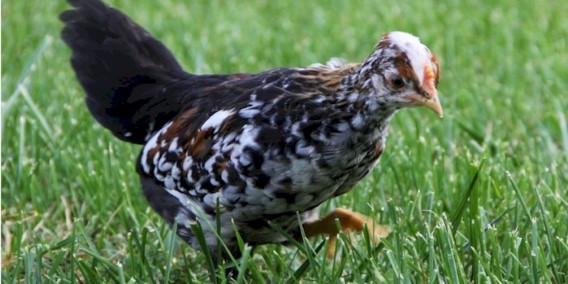Swedish Flower
Chickens’ name is inspired mottling of their feather tips that resemble a field
of blooming flowers. Their base coloring varies from black, yellow, red or
blue. All of these variations contain the mottling pattern.
Domestic
chickens were introduced to Sweden about 2000 years ago, brought to the country
by traders, settlers and even Viking marauders. Today it is unknown what or how
many varieties of chickens were brought to Sweden’s shores in those early days,
but that unknown mix of birds propagated over the next two-thousand years,
developing into what are now considered the country’s native breeds.
They are a
landrace breed. This means that they developed naturally over hundreds of
years. As a Darwinist creation, human intervention and selective breeding never
played a role in the development of the breed. Chicks hatched from random
pairings of the strongest, hardiest birds in each flock to create a genuinely
robust breed of chicken. The Swedish Flower Hen or Skansk blommehona, developed
in the southern part of Sweden over the last 500 years. As the weather is
generally mild in these areas providing favorable conditions for the
development of the breed, the Swedish Flower Hen became the largest of Sweden’s
native breeds. Farmers considered it a dual purpose chicken, favored for both
its ability as an egg layer and for its meat.
Named for its
colorful, spotted plumage, Skansk blommehona literally translates to “bloom hen.”
The white-tipped feathers make the birds look like a field of blooming flowers.
The base color of the birds can be black, blue-gray, reddish-brown, off-white,
red or yellow. Almost all of the color variety will have white on the tips of
the feathers, giving the bird the spotted appearance. Some blue-gray based
birds show more of a darker lacing around the feather edges as opposed to the
white markings, but those tend to be the exception to the “spotted” rule.
White-based birds often have darker markings on the feathers, but can also be
predominately white.
While flocks
of Swedish Flower Hens were quite prevalent throughout the villages in the
southern part of the country for hundreds of years, the breed began to fade out
in the late 1800’s with the introduction of imported chicken breeds bred
specifically for high egg production or greater meat yield. By the mid 1900’s,
the Swedish Flower Hen was a rarity in the country of its creation.
Swedish Flower
chickens were was close to extinction in 1970, when a group of enthusiasts
discovered 3 remaining flocks in Sweden. A breeding program was established to
help grow the population. In 2010 the breed was introduced to America.

